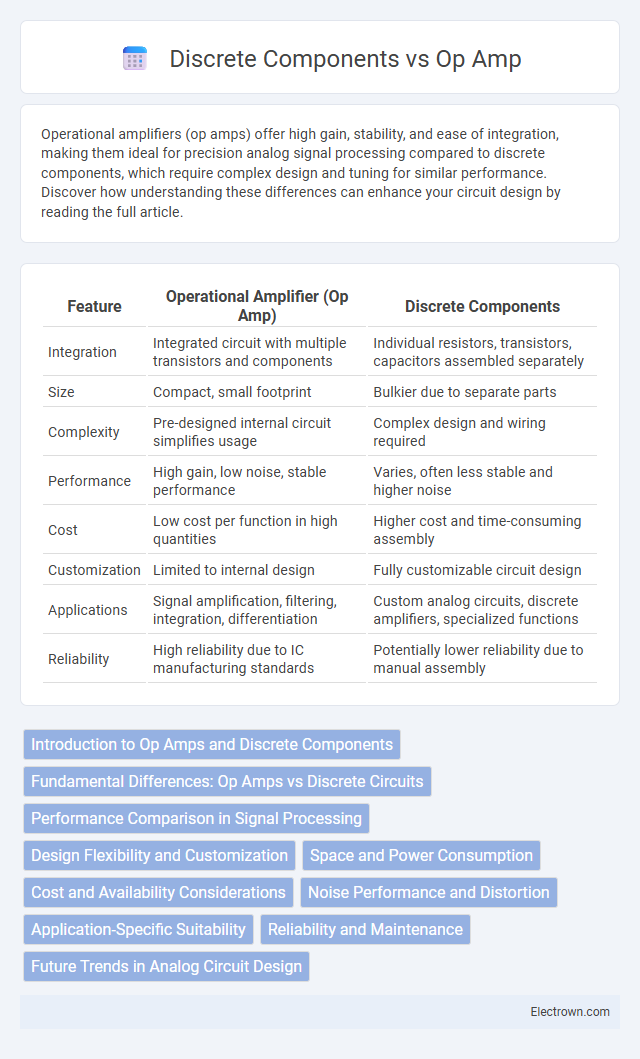Operational amplifiers (op amps) offer high gain, stability, and ease of integration, making them ideal for precision analog signal processing compared to discrete components, which require complex design and tuning for similar performance. Discover how understanding these differences can enhance your circuit design by reading the full article.
Table of Comparison
| Feature | Operational Amplifier (Op Amp) | Discrete Components |
|---|---|---|
| Integration | Integrated circuit with multiple transistors and components | Individual resistors, transistors, capacitors assembled separately |
| Size | Compact, small footprint | Bulkier due to separate parts |
| Complexity | Pre-designed internal circuit simplifies usage | Complex design and wiring required |
| Performance | High gain, low noise, stable performance | Varies, often less stable and higher noise |
| Cost | Low cost per function in high quantities | Higher cost and time-consuming assembly |
| Customization | Limited to internal design | Fully customizable circuit design |
| Applications | Signal amplification, filtering, integration, differentiation | Custom analog circuits, discrete amplifiers, specialized functions |
| Reliability | High reliability due to IC manufacturing standards | Potentially lower reliability due to manual assembly |
Introduction to Op Amps and Discrete Components
Operational amplifiers (op amps) are integrated circuits designed to amplify voltage signals with high gain, input impedance, and bandwidth, enabling versatile applications in analog electronics. Discrete components, such as transistors, resistors, and capacitors, provide fundamental building blocks assembled individually to create amplification and signal processing circuits. While op amps offer compactness and consistency, discrete components allow custom-tailored performance and flexibility for specialized analog designs.
Fundamental Differences: Op Amps vs Discrete Circuits
Op amps are integrated circuits designed to provide high gain and precise amplification using multiple transistors and resistors internally optimized for linearity and stability. Discrete circuits use individual components like transistors, resistors, and capacitors arranged externally, offering more design flexibility but requiring careful tuning for performance consistency. Your choice between op amps and discrete components depends on the application's complexity, precision needs, and space constraints.
Performance Comparison in Signal Processing
Operational amplifiers deliver superior consistency and high gain-bandwidth products compared to discrete components, enabling more accurate and stable signal processing. Discrete components offer customizable performance by selecting individual transistors and resistors, but this often results in increased noise and variability. For precision signal amplification and filtering, integrated op amps typically outperform discrete circuits due to minimized parasitic effects and optimized internal compensation.
Design Flexibility and Customization
Op amps offer limited design flexibility due to their fixed internal architecture, making them ideal for standard applications with predictable behavior. Discrete components provide extensive customization options by allowing you to tailor each stage of the circuit, optimizing performance for specific requirements such as gain, bandwidth, and noise levels. Your choice between op amps and discrete components depends on the balance between ease of implementation and the need for precise, application-specific adjustments.
Space and Power Consumption
Operational amplifiers (op amps) significantly reduce space and power consumption compared to discrete component circuits by integrating multiple transistors into a single compact package. This integration enables lower quiescent current and optimized power efficiency through advanced semiconductor fabrication techniques. Discrete components typically require larger board area and higher power due to individual device overhead and less efficient biasing networks.
Cost and Availability Considerations
Op amps offer a cost-effective and readily available solution for implementing amplification in electronic circuits compared to discrete components, which often require multiple individual parts, increasing overall expense and assembly complexity. The integration of transistors, resistors, and capacitors within a single op amp package reduces procurement time and stock management challenges, benefiting budget-conscious design projects and mass production. Discrete components may be preferred for specialized or high-power applications but generally incur higher costs and availability risks due to the need for precise matching and additional supporting components.
Noise Performance and Distortion
Operational amplifiers (op amps) typically offer superior noise performance due to integrated design optimizations, including matched transistor pairs and internal feedback, resulting in lower input-referred noise compared to discrete components. Discrete components can introduce higher distortion levels and more variable noise due to component tolerances and layout inconsistencies, impacting linearity and overall signal integrity. Precision op amps designed for low distortion and noise are preferred in high-fidelity applications, while discrete designs may be customized but often trade off noise performance for flexibility.
Application-Specific Suitability
Op amps offer versatile and highly integrated solutions ideal for a wide range of general-purpose signal processing applications, delivering consistent performance with minimal design effort. Discrete components provide greater customization and can be optimized for specific high-frequency, high-power, or unique analog circuit requirements where Op amps might fall short. Your choice depends on the application-specific suitability, balancing design complexity, precision, and performance needs.
Reliability and Maintenance
Operational amplifiers (op amps) offer higher reliability compared to discrete components due to integrated circuitry that minimizes component variation and thermal stress. Maintenance demands are lower for op amps because their standardized packaging reduces the risk of solder joint failures and simplifies replacement. Discrete components require frequent calibration and inspection, increasing downtime and risk of malfunction in complex circuits.
Future Trends in Analog Circuit Design
Future trends in analog circuit design emphasize the integration of operational amplifiers (op amps) with discrete components to achieve enhanced performance and miniaturization. Advances in semiconductor technology enable op amps to deliver higher precision, lower power consumption, and increased bandwidth compared to traditional discrete transistor-based circuits. Emerging applications in IoT and wearable devices drive the development of hybrid analog solutions that optimize both flexibility and efficiency in signal processing.
op amp vs discrete components Infographic

 electrown.com
electrown.com